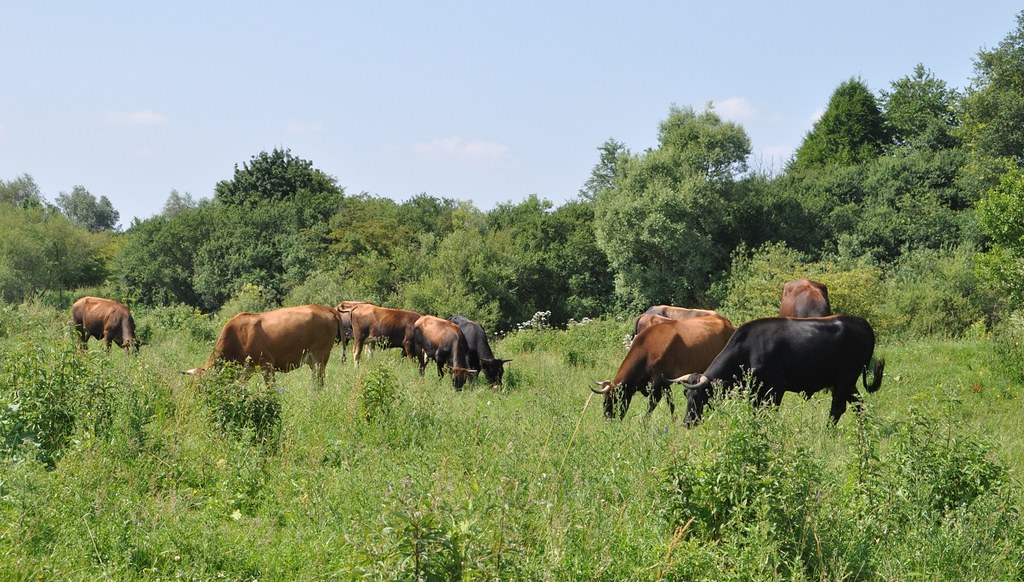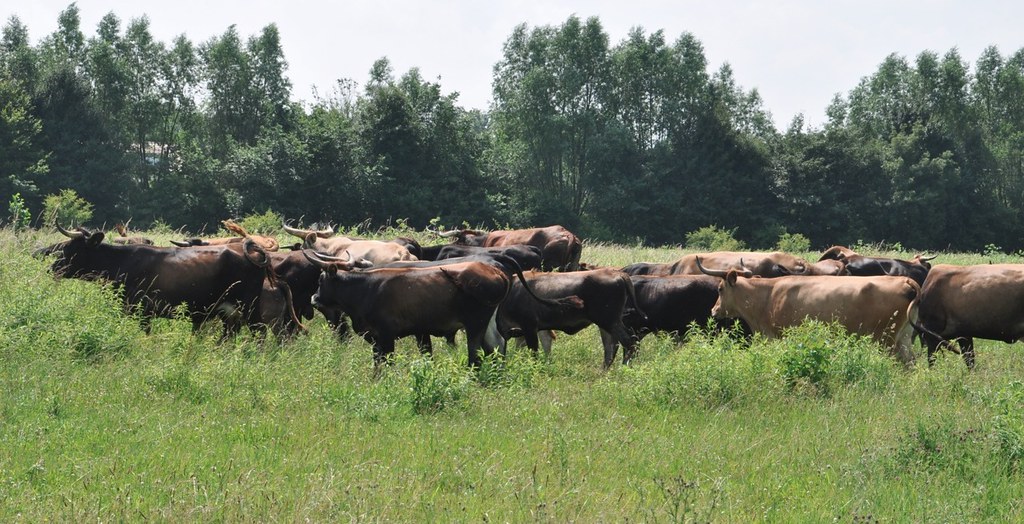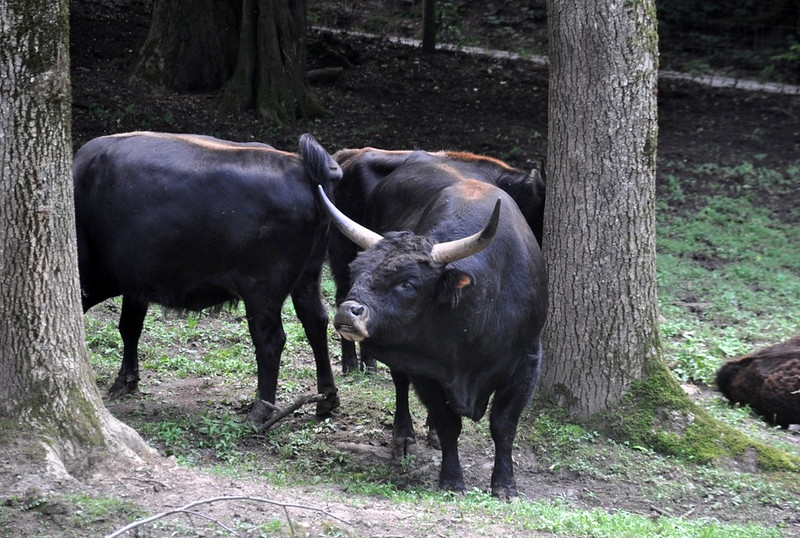All members
of the Bovini, including domestic cattle, have a more or less similar social
behaviour, and so the aurochs probably showed the same behavioural patterns
that all its relatives and descendants do. Only few aspects of the aurochs’
behaviour have been documented, mostly in Schneeberger’s report to Conrad
Gesner from 1602. But most of what is described in this document is congruent with
those of domestic cattle, for example the flehmen gesture, the way cows look
for their calves or impressing behaviour by the bulls. All cattle have the same
and comparably complex social and reproductive behaviour that also resembles
the other bovine species, indicating that it is not greatly altered by
domestication. Therefore I assume that
the behaviour of the aurochs was very similar if not identical to that of
domestic cattle. The following passages are based on observations of living domestic
cattle (Camargue, Chillingham cattle, Heck cattle, Highland cattle, Galloway) and
wild bovines as much as on Schneeberger’s report. I am going to use photos of
more or less aurochs-like cattle on a relatively natural-looking background
here to show the behaviour patterns described in the text.
Herd structure
Cattle form
herds all year round, even tough Schneeberger reports that aurochs roam
separately during summer [1]. Probably he spotted single bulls since these
usually separate themselves from the herds that are formed by cows and
juveniles. These herds have a matriarchal structure [2] and wander around
looking for feeding grounds. The usual herd size for cattle is between 20 and
30 animals [3]. If the number of the animals within the herd grow larger, the
herd splits up [2]. The cows form sub groups of two or three animals that graze
and rest together. The distance between the individuals depends on the social
rank and lies between 0,5 and 3 meters [4]. Friendly behaviour includes licking
and stroking with the horns. Calves form “kindergarden groups” when their
mothers are occupied with grazing and gestating, which are guarded by
non-suckling cows or young bulls. The latter leave the herd at the age of 1,5
years when becoming sexually mature.
Adolescent
bulls form bull groups, which is common to most bovines (therefore I was a
little bit upset when an individual on deviantArt called this behaviour
“speculative” commenting this illustration). These bull groups circle around
the cow herds, and each group mates with cows of different herds each
respective year, what can be interpreted as a mechanism against inbreeding [2].
Bulls only join the herd during mating season. The common presence of bulls
within cow/calf herds in some free-ranging domestic cattle populations might be
explained by the loss of seasonality in the reproductive circle of domestic
cattle [3]. If the place is confined, cattle form a herd of all age classes and
both sexes [3], so the herding behaviour apparently is plastic.
| Mixed-sex herd |
Older bulls
from an age of 10 to 12 separate from the bull group to avoid the constant
competition with the other bulls. These old bulls are solitary, territorial and
do not partake in reproduction anymore. The maximum life expectancy of cattle
is about 20 years [5]. In wild aurochs it probably was a little shorter, and
also Schneeberger reported that aurochs lived for only 15 years [1].
When cattle
are alarmed or start to flee, they do not stray up but stay close together.
Like many other large ungulates, they form a defensive circle around their
calves [1].
Agonistic behaviour
Cattle are
hierarchic animals and there is a dynamic social order within a herd. This
order is not linear but polygonal, f.e. C < A < B < C. The higher the
rank of an animal the higher the quality of food and resting places, and the
lower the level of stress because a lower rank in the hierarchy means that is
constantly dominated by other herd members. Dominating behaviour includes display
like standing in front of the opponent in an angle of 90° and elevating the
head to show off its full size, or hits with the horns and pushing the
individual aside. If the conflict does not end here, a combat fight follows,
which is carried out head-to-head by pushing and pulling the opponent with the
horns until it retreats. The winner might chase the loser for a few seconds. Harsh
fights take place by bulls as much as cows [2,3,4,5]. Free ranging cattle, especially
bulls, often show the results of such fights: scars along the neck and
shoulders, broken-off horn tips, ear cuffs ripped apart, and sometimes even a
stabbed eye. Superiority does not necessarily depend on mass and strength only
– the size and shape of the horns plays a role as well, as much as the psyche
of the animal [3,4].
Reproductive behaviour
Bulls also
show off their strength by throwing dust and plant material into the air with
their horns and hooves (which is also reported by Schneeberger), omitting a
growling sound. Bulls in a rut also make repetitive, trumpeting sounds which I
guess are used to attract cows and intimidate other bulls. For videos showing
the behaviours I just described, see here, here, here and here.
Cattle form
harems during the mating season, which under natural circumstances usually
takes place during late august* [1]. The traditional image that one bull
conquers a harem and is the only male who covers the cows is not correct. In
fact there is a number of other bulls that seize their chances when the leader
of the harem is busy at the moment, but it is the cow’s choice which bull mates
with her. Bulls in heat show the so-called flehmen gesture by curling back their
upper lip and stretching out the tip of the tongue in order to detect
pheromones and other scents with their vomeronasal organ. After three days of
testing the cow’s scent and urine, the bull mates with the cow. Friendly
behaviour between bull and cow like licking and stroking with the horns usually
are restricted to the mating season.
* Domestic cattle in man’s custody mate all year round, but if exposed
to natural factors and natural selection in particular, their reproductive
circle becomes seasonal again like in all large wild mammals. Aurochs
apparently had the same rhythm.
After
mating, a nine month-long pregnancy starts. The behaviour of the cow
immediately before birth probably depends on habitat [3]. If forest edges and
bushes are available as shelter, the cow separates from the herd a few days or
hours before birth [3,5]. On open grassland, the cows might tend to calf near
to the herd [4]. The new-born calf immediately tries to make its first step
while the mother is licking its wet fur [5]. The placenta arrives a few hours
after birth and is consumed by the mother. As soon as the calf is able to walk,
the cow takes it away from the birth site to not attract predators. The first
milk the calf consumes is called colostrum and is very alimentary. The
mother-calf bond is formed within three days. Mother and calf recognize each
other by scent, voice and looks. While the mother grazes in the herd, the calf
is hidden between bushes or at a forest edge, where it is exposed to predators
[1,5].
Literature
[1] van Vuure, Cis: Retracing the Aurochs - History, Morphology
and Ecology of an extinct wild Ox. 2005
[2] Meissner
& Limpens: Dedomestikation – wilde Herden zwischen den Menschen. 2001
[3] Julia
Poettinger, 2011: Vergleichende Studie zur Haltung und zum Verhalten des Wisents
und des Heckrinds.
[4] Annette
Perrey: Die Sozialstruktur einer Herde
Auerochsen im Wildgehege Neandertal. 1999
[5] Frisch,
Walter: Der Auerochs – das europäische Rind. 2010.






Indian Animals Cow Latest HD Images Cow Milk Photos
ReplyDeleteSome photos and illustrations:
ReplyDeletehttp://www.ruralbit.pt/
http://autoctones.ruralbit.com/
http://ilustracoes.ruralbit.com/
http://www.marones.pt/
http://www.cachena.pt/
http://www.cachena.es/
http://www.cachena.de/de/index.htm
http://tvbarroso.com/tvb/
http://tvbarroso.com/chegas/chegas.html
http://tvbarroso.com/tvb/final-campeonato-outras-racas-2017/
http://www.alterreal.pt/
http://www.aepga.pt/
http://www.bucardo.es/
http://www.avph.com.br/
http://www.arkive.org/
https://www.youtube.com/watch?v=PDoLkGObxZI
https://www.youtube.com/watch?v=D4Xk3MVmvjs
http://www.tvbarroso.com/
Deletehttps://alterreal.pt/
https://www.aepga.pt/
https://www.atlasvirtual.com.br/
https://www.arkive.org/
https://www.wildscreen.org/
https://www.wildscreen.org/arkive-closure/
https://www.lifemaronesa.eu/
Deletehttps://www.marones.pt/
http://www.marones.pt/
http://www.amiba.com.pt/
Deletehttp://www.amiba.pt/
https://terramaronesa.pt/
Deletehttps://www.facebook.com/AlterReal/
ReplyDeletehttps://www.facebook.com/aepga/
https://www.facebook.com/casa.da.cisterna/
https://www.facebook.com/achegas
Deletehttps://www.facebook.com/Ra%C3%A7a-Barros%C3%A3-104128218033381
https://www.facebook.com/TourosViana/
Deletehttps://www.facebook.com/tvbarroso/
https://www.facebook.com/Raza-Serrana-Negra-1012453112106334/
https://www.facebook.com/Raza-Serrana-Negra-1607378646214273/
https://www.facebook.com/PolskaFundacjaOdtworzeniaTura/
https://www.facebook.com/aurochsproject/
https://www.facebook.com/ruralbit/
https://www.facebook.com/AMIBA-Associa%C3%A7%C3%A3o-dos-Criadores-de-Bovinos-de-Ra%C3%A7a-Barros%C3%A3-2120849248213603/
Deletehttps://www.facebook.com/fncpp/
https://www.facebook.com/Chegas-J%C3%BAnior-Artur-106301210741046/
https://www.facebook.com/sprega.pt/
https://www.facebook.com/SOS-Equinos-476091839104324/
https://www.facebook.com/razasibericas/
https://www.facebook.com/Monte-Frio-Alpacas-212360912264905/
https://www.facebook.com/Cebro-Encebra-o-Tarp%C3%A1n-ib%C3%A9rico-481341095648887/
https://www.facebook.com/APSL.Cavalo.Lusitano/
https://www.facebook.com/coudelariaquintadesaojose/
https://www.facebook.com/Garranos-casa-machado-100604565462269/
https://www.facebook.com/CoudelariaFB/
https://www.facebook.com/Associa%C3%A7%C3%A3o-O-Caminho-do-Garrano-1940938019524183/
ReplyDeletehttps://www.facebook.com/PR-pequenos-Ruminantes-620358731637712/
https://www.facebook.com/AMIBA-Associa%C3%A7%C3%A3o-dos-Criadores-de-Bovinos-de-Ra%C3%A7a-Barros%C3%A3-2120849248213603/
Delete